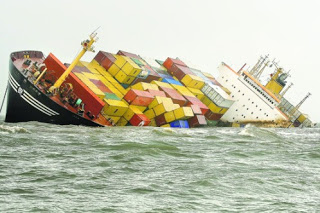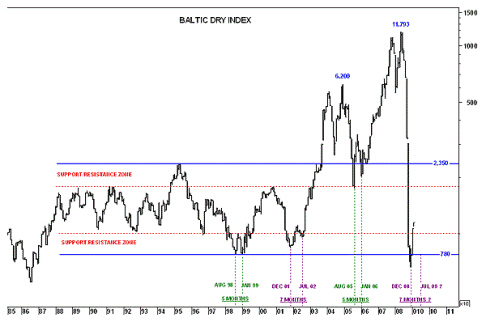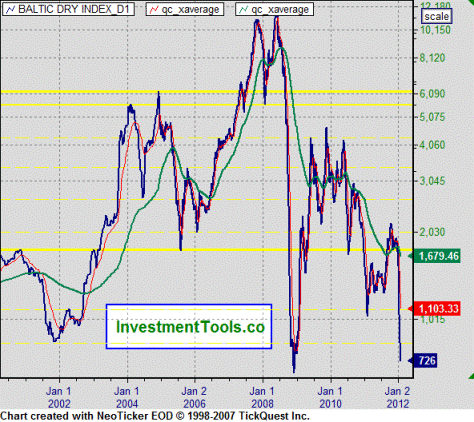 |
| Shipping tipping point? |
Brandon Smith, Contributing Writer
Activist Post
Much has been said about the Baltic Dry Index over the course of the last four years, especially in light of the credit crisis and the effects it has had on the frequency of global shipping. Importing and exporting has never been quite the same since 2008, and this change is made most obvious through one of the few statistical measures left in the world that is not subject to direct manipulation by international corporate interests; the BDI. Today, the BDI is on the verge of making headlines once again, being that is plummeting like a wingless 747 into the swampy mire of what I believe will soon be historical lows.
The problem with the BDI is that it is little understood and often dismissed by less thoughtful economic analysts as a “volatile index” that is too “sensitive” to be used as a realistic indicator of future trends. What these analysts consistently seem to ignore is that regardless of their narrow opinion, the BDI has been proven to lead economic derision in the market movements of the past. That is to say, the BDI has been volatile exactly because markets have been volatile and unstable, and is a far more accurate thermometer than those that most mainstream economists currently rely on. If only they would look back at the numbers further than one year ago, they might see their own folly more clearly.
Introduced in 1985, the Baltic Dry Index first and foremost is a measure of the global shipping rates of dry bulk goods, mostly consisting of vital raw materials used in the creation of other products. However, it is also a measure of demand for said materials in comparison to previous months and years. This is where we get into the predictive nature of the BDI….
In late 1986, for instance, the BDI fell to its lowest level on record, then, began a slow crawl towards moderate recovery, just before the Black Monday crash of 1987.
Coincidence? Not a chance. From 2001 to 2002, a similar collapse in the BDI preceded a progressive drop in the Dow of around 4000 points, ending in a highly suspect (Fed engineered) illegitimate recovery. In 2008, the index fell to near record lows once again just before the derivatives and credit crisis hit stocks full force. To imply that the BDI is not a useful measure of future economic trends seems like an astonishingly ignorant proposition when one examines its very predictable behavior just before major financial downturns.
This is not to suggest that the BDI can be used as a way to play the stock market from day to day, or even month to month. MSM analysts rarely look further than the next quarter when considering any financial issue, and that is why they don’t understand the BDI. If an index cannot be used by daytraders to make a quick buck in a short afternoon, then why bother with it at all, right? The BDI is not an accurate measure of the daily market gamble. It is, though, an accurate measure of where markets are headed in the long run and under extreme circumstances.
Over the course of the past month, the BDI has fallen around 65% from above 1600 to 726. Mainstream economists argue that the BDI’s fall in 2008 was a much higher percentage, and thus, a 65% drop is nothing to worry about. They fail to mention that shipping rates never recovered from the 2008 collapse, and have hovered in a sickly manner near lows reached during the initial credit bubble burst. By their logic, if the BDI was at 2, and fell to 1, this 50% drop should be shrugged off as inconsequential because it is not a substantial percentage of decline when compared to that which occurred in 2008, even though the index is standing at rock bottom. Yes, the useful idiots strike again….
Looking at the rate and the speed of decline this past month, it’s hard to argue that the current 65% drop is meaningless:
Another subversive argument against the BDI is the suggestion that it is not the demand for raw materials that is in decline, but the number of shipping vessels out of use that is growing. A smart person might suggest that these two problems are mutually connected. An MSM pundit would not.
In 2008, many ships were left to wallow in port without cargo, but this was due in large part to two circumstances. First, demand had fallen so much that too many ships were left to carry too little raw materials. Second, credit markets had sunk so intensely that many ships could not find trade financing necessary to take on cargo. In either case, the BDI still falls, and in either case, it still signals economic danger. The only way that the BDI could signal a major decline in shipping demand artificially or inaccurately is if a considerable number of ships under construction were suddenly released onto the market while there is no demand for them. There have been no mass increases or extreme changes in cargo fleets this past month, or at all since 2008, which means, the BDI’s decline has nothing to do with the number of ships in operation, and everything to do with decline in global demand.
 |
| Free Copy of the American Expat Guide |
What is the bottom line? The stark decline in the BDI today should be taken very seriously. Most similar declines have occurred right before or in tandem with economic instability and stock market upheaval. All the average person need do is look around themselves, and they will find a European Union in the midst of detrimental credit downgrades and on the verge of dissolving. They will find the U.S. on the brink of yet another national debt battle and hostage to a private Federal Reserve which has announced the possibility of a third QE stimulus package which will likely be the last before foreign creditors begin dumping our treasuries and our currency in protest. They will find BRIC and ASEAN nations moving quietly into multiple bilateral trade agreements which cut out the use of the dollar as a world reserve completely. Is it any wonder that the Baltic Dry Index is in such steep deterioration?
Along with this decline in global demand is tied another trend which many traditional deflationists and Keynesians find bewildering; inflation in commodities. Ultimately, the BDI is valuable because it shows an extreme faltering in the demand for typical industrial materials and bulk items, which allows us to contrast the increase in the prices of necessities. Global demand is waning, yet prices are holding at considerably high levels or are rising. Indeed, the most practical conclusion would be that the monster of stagflation been brought to life through the dark alchemy of criminal debt creation and uncontrolled fiat stimulus. Without the BDI, such disaster would be much more difficult to see foresee, and far more shocking when its full weight finally falls upon us. It must be watched with care and vigilance….
Brandon Smith is the founder of Alt-Market is an organization designed to help you find like-minded activists and preppers in your local area so that you can network and construct communities for mutual aid and defense. Join Alt-Market.com today and learn what it means to step away from the system and build something better or contribute to their Safe Haven Project. You can contact Brandon Smith at: brandon@alt-market.com
linkwithin_text=’Related Articles:’




Be the first to comment on "Baltic Dry Index Signals Renewed Market Collapse"